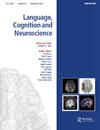成分频率和干扰物类型对新生复杂词汇学习的影响
IF 1.8
3区 医学
Q2 AUDIOLOGY & SPEECH-LANGUAGE PATHOLOGY
引用次数: 0
摘要
摘要本研究探讨成分频率和干扰物类型在复杂单词学习中的作用。熟练的读者被训练将小说字母串与两幅图片中的一幅联系起来,其中一幅作为目标,另一幅作为干扰。第一成分频率的促进效应仅在干扰物促进第一成分学习的试验中被发现,第二成分频率的促进效应仅在干扰物促进第二成分学习的试验中被发现,反之则没有。在学习过程中,在没有任何预先存在的关于组成语素的知识和任何对组成成分的明确参考的情况下,学习发生了。研究结果指出,词频和干扰物类型在新单词学习中的重要作用,并为成人学习者内隐获取词形知识的机制提供了见解,我们认为这是语言学习的一个关键方面。关键词:新词学习成分频率干扰物类型形态学知识披露声明作者未报告潜在利益冲突。数据可用性声明资料、数据和分析脚本已通过以下链接提供:https://osf.io/r3cdf/?view_only = c9bd1f5142724e59878d14d5deae8cb0。本研究得到了语言、交流和大脑卓越中心(France2030, anr -16- convo -0002)、艾克斯-马赛大学卓越计划(ANR-11-IDEX-0001-02)和教育教师培训和研究试点中心(AMPIRIC)的支持。该研究由ANR拨款(MORPHEME ANR-15- fral -0003-01)直接资助,并获得了ERC拨款742141的额外支持。EB得到了FYSSEN奖学金的支持。本文章由计算机程序翻译,如有差异,请以英文原文为准。
The effect of constituent frequency and distractor type on learning novel complex words
ABSTRACTThe present study explored the role of constituent frequency and distractor type in complex word learning. Skilled readers were trained to associate novel letter strings with one out of two pictures, with one picture serving as the target, and the other as a distractor. A facilitatory effect of first-constituent frequency was found only in trials where distractors promoted first-constituent learning, and a facilitatory effect of second-constituent frequency only in trials where distractors promoted second-constituent learning, but not vice versa. Learning occurred in the absence of any pre-existing knowledge about the constituent morphemes and any explicit reference to the constituents during learning. The results point to the important role of constituent frequency and distractor type in novel word learning and provide insights into the mechanisms involved in the implicit acquisition of morphological knowledge in adult learners, that we suspect to be a key aspect of language learning in general.KEYWORDS: Novel word learningconstituent frequencydistractor typemorphological knowledge Disclosure statementNo potential conflict of interest was reported by the author(s).Data availability statementMaterials, data and analyses scripts have been made available under the following link: https://osf.io/r3cdf/?view_only = c9bd1f5142724e59878d14d5deae8cb0.Additional informationFundingThis research was supported by the center of excellence on Language, Communication and the Brain (France2030, ANR-16-CONV-0002), the Excellence Initiative of Aix-Marseille University A*MIDEX (ANR-11-IDEX-0001-02), and the pilot center for teacher training and research in education (AMPIRIC). The research was directly funded through an ANR grant (MORPHEME ANR-15-FRAL-0003-01) with additional support from ERC grant 742141 awarded to JG. EB was supported by a FYSSEN Fellowship.
求助全文
通过发布文献求助,成功后即可免费获取论文全文。
去求助
来源期刊

Language Cognition and Neuroscience
AUDIOLOGY & SPEECH-LANGUAGE PATHOLOGY-BEHAVIORAL SCIENCES
CiteScore
4.50
自引率
13.00%
发文量
70
期刊介绍:
Language, Cognition and Neuroscience (formerly titled Language and Cognitive Processes) publishes high-quality papers taking an interdisciplinary approach to the study of brain and language, and promotes studies that integrate cognitive theoretical accounts of language and its neural bases. We publish both high quality, theoretically-motivated cognitive behavioural studies of language function, and papers which integrate cognitive theoretical accounts of language with its neurobiological foundations.
The study of language function from a cognitive neuroscience perspective has attracted intensive research interest over the last 20 years, and the development of neuroscience methodologies has significantly broadened the empirical scope of all language research. Both hemodynamic imaging and electrophysiological approaches provide new perspectives on the representation and processing of language, and place important constraints on the development of theoretical accounts of language function and its neurobiological context.
 求助内容:
求助内容: 应助结果提醒方式:
应助结果提醒方式:


